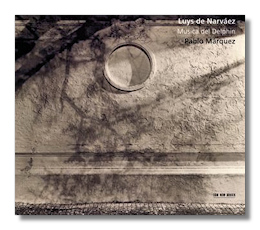
The Internet's Premier Classical Music Source
Related Links
- Latest Reviews
- More Reviews
-
By Composer
-
Collections
DVD & Blu-ray
Books
Concert Reviews
Articles/Interviews
Software
Audio
Search Amazon
Recommended Links
Site News
 CD Review
CD Review
Luys de Narváez

Musica del Delphin
- Primer tono por ge sol re ut
- Segundo tono
- Tercero tono
- Quarto tono
- Quinto tono de consonancia
- Sesto tono sobre fa ut re mi
- Septimo tono sobre ut re mi fa mi
- Octavo tono
- Cancion del Emperador
- Sanctus y Hosanna
- Diferencias sobre Conde Claros
- Diferencias sobre el himno O Gloriosa Domina
- Je veulx laysser melancolie de Richafort
- Fantasia del primer tono
- Fantasia del quarto tono
- Fantasia del quinto tono
- Baxa del contrapunto
Pablo Márquez, guitar
ECM New Series 1958 DDD 46:12
Luys (or Luis) de Narváez lived in the 1500s and today is most famous for music he wrote for the vihuela, a relative of the guitar and the lute. (During his own time, however, he probably would have been more famous for his polyphonic vocal music.) In 1538, his music for vihuela was published in a collection called Los seys libros del Delphin de musica de cifra para tañer vihuela. Los seys libros were dedicated to Francisco de los Cobos, who was in the service of King Carlos I, and whose title was "comendador de León."
The booklet note by Thierry Rougier deals at some length with Narváez's achievements, which include the refinement of the theme-and-variations genre (which he referred to as "diferencias"), and the use of the so-called "golden ratio" in the construction of his works. Narváez also helped to preserve the music of his era and the recent past by arranging it for vihuela. The Cancion del Emperador ("Song of the Emperor") is based on Josquin's Mille Regretz, for example. That is among Narváez's most famous works. (Another is Diferencias sobre Guárdame las vacas – unfortunately, not included on this CD).
There also is a short personal essay by the performer, guitarist Pablo Márquez, "Luys de Narváez has remained a passion of mine," he writes, "never failing to move me with the mystical nature of his music and the crystal clarity of his discourse." Although the guitar and the vihuela are related, there are important differences between the two (in timbre, in tuning, and so on), and one well might ask: why the guitar, particularly when modern reproductions of the vihuela exist, and there are excellent recordings of Narváez's music available on such "authentic" instruments? I suppose the answer simply is that Márquez plays the guitar and not the vihuela, and that he did not want to surrender the opportunity to play these works. I am sure that this will not be good enough for some people, and they will disqualify this CD without having heard it.
That would be too bad, as Márquez has something of value to say in this repertoire. He is an intelligent, serious musician who clearly is trying to reach the heart of Narváez. Also, the sound of his instrument – a guitar built in 1972 by Daniel Friederich – is gorgeous.
Of course, as I mentioned above, the sound of the guitar is very different from that of the vihuela. A guitar is richer and more three-dimensional. A vihuela sounds smaller and more metallic. It is like comparing a grand piano to a harpsichord. I can listen to Bach's Goldberg Variations played on either, and enjoy both performances. The same is true here.
If you'd like to hear this music played with more "authenticity," whatever that means, there is a fine CD from Naxos (8.553523) featuring Christopher Wilson playing the vihuela. It is interesting to compare not only the instruments but also the manner in which they are played. Márquez treats the music with much more freedom than Wilson. If one compares the Fantasia del quinto tono (track 3 on Márquez's CD, and track 11 on Wilson's), one is almost shocked by how much faster Márquez is, and how his beat is far less regular. Listening to Márquez, one hears Spanish music first and Early Music second. Listening to Wilson, the priorities are reversed. Interesting. I can't say which I prefer, because they are so different.
Márquez receives excellent engineering from ECM. It is so close, however, that the microphone(s) pick up guitar "noise" – unintentional sonic artifacts associated with clothing or body parts brushing against the strings or the body of the guitar. Quite often, I thought my cat was softly scratching to come in. No matter. It actually adds to the late-evening pleasantness of this CD.
Copyright © 2007, Raymond Tuttle




















